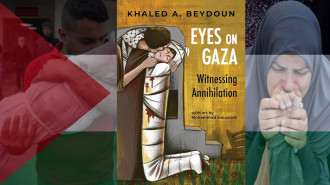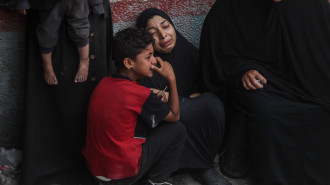
Ten years after the Sinjar massacre, Yazidi women are fighting back

Ten years ago on August 3, the Islamic State group (IS) began its genocidal assault on the Yazidis, an ethno-religious minority in northern Iraq.
At least 5,000 Yazidis were killed, and an estimated 7,000 Yazidi women and children were kidnapped and forced into sexual slavery by IS fighters.
Holya, Berivan, and Fahima — three Yazidi women from Sinjar — managed to escape the attack and are now rebuilding their lives and communities more than six years after the defeat of IS in the country.
The women work as deminers for the British demining charity Mines Advisory Group (MAG). They clear Sinjar, the Yazidis' ancestral homeland, and the surrounding area of improvised explosive devices (IEDs) and other explosive ordnance left behind from the war with the terrorist group.
All three women were displaced from their homes when IS attacked and lost relatives, but they are determined to make Sinjar safe again.
“With every landmine we clear, we are victorious over Daesh [Arabic word for IS] again and again,” said 28-year-old Fahima Elyas.
“Before the war, women had traditional roles in the community, but after the war, it became accepted that we could do different jobs and contribute in different ways. We became nurses, teachers, deminers. This is such a source of pride for us.
“I do this work to send IS a message: they took our girls, and I couldn’t hold a gun to protect them, but I can hold a detector and clean the area where they left the remnants of the war,” added Fahima.
A deadly legacy
The war with IS left a massive amount of explosive ordnance across Iraq — a deadly legacy that still kills and maims civilians to this day.
Estimates of the initial extent of contamination in Sinjar vary. However, an assessment using the best available data indicates that approximately 107 square kilometres of Sinjar was left contaminated with IEDs and explosive ordnance following the war, including booby traps left in homes.
In the last four years alone, MAG has cleared almost 24 square kilometres of contaminated land and removed nearly 6,000 items of explosive ordnance in Sinjar and Tel Afar.
However, contamination — and challenges — remain.
Much of the infrastructure in Sinjar is still devastated, with many Yazidis still living in IDP camps and stuck in limbo. Meanwhile, many Yazidis remain missing, and there is a lack of justice and accountability for the survivors.
Berivan Khider, 31, fled with her family for 24 hours without rest when IS attacked Sinjar. She managed to escape, but many others did not.
“There were a lot of girls who returned and told us they’d been sold 20 times to different men,” said Berivan.
“Girls said they sold us for 500 dinar — 30p. They sleep with a girl for one night or ten nights. They use girls like a jacket; they wear it for a while until it feels boring.”
Berivan’s father was taken hostage by IS militants in 2007, who demanded a ransom of 55 million Iraqi dinar (£33,000).
The family had to sell their home, possessions, and Berivan’s gold earrings to pay for his release. Now, he is unable to work due to the injuries he sustained during the kidnapping.
Currently, Berivan rents a house in Sinjar with some other women, while her family rents a house next to an IDP camp near Duhok.
Fahima is a MAG team leader. She was 18 and studying at sixth form when IS attacked. Her family woke her up early in the morning, telling her they had to run.
“We fled at about 11 am, and Daesh arrived very soon after. I have three brothers and three sisters, and we couldn’t all escape together. I ran into the street, and a car stopped to rescue me and take me to safety,” she said.
“We were in the car, and we could hear the bullets and the gunfire. As women, we were very afraid of what would happen to us. All the people in the community were helping one another.
"The men were all willing to sacrifice their lives so their sisters, daughters, and wives could escape. My father and brother stayed behind to make sure the rest of the family could escape, and they were able to escape later,” she added.
Fahima and her family fled to Duhok, a nearby city where many Yazidis were displaced.
“We returned to our family home in 2016, not too long after the liberation of Sinjar,” she continued.
When she did, she found her house booby-trapped extensively by IS, including an IED wired up to a box of chocolates and a large, bloody knife in her bedroom, which she believes was used for beheadings.
Her experience made her want to help clear the remnants of war so other families could return home.
“My mum was very afraid when I started doing the landmine clearance work, but all of my family and the wider community are incredibly supportive of what we do. They see this work as honourable work — making our homeland safe,” she commented.
Holya Morad was only 16 when she fled Sinjar with eight of her relatives in one car and drove into the mountains.
“I didn’t believe it would go on this long. I thought maybe two or three days; that the government wouldn’t allow them to do this to our families and our girls,” the 26-year-old said.
“We didn’t expect so much devastation — kidnapping and killing people.
"My house is destroyed; I can’t go home now, but I can help other people go home,” she concluded.
All picture credits to Sane Seven
Jessie Williams is a freelance journalist, editor, and writer based in London. Her interest lies in global current affairs, humanitarian issues, women's rights, migration, culture, and politics to explore the human stories behind the headlines
Follow her on X: @JessieWill5







 Follow the Middle East's top stories in English at The New Arab on Google News
Follow the Middle East's top stories in English at The New Arab on Google News


